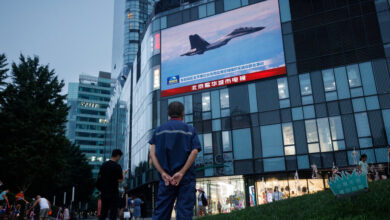As Prices Soar in Ukraine, War Adds Economic Havoc to the Human Toll

LVIV, Ukraine — At his compact stall in Lviv’s main outdoor food market, Ihor Korpii arranged jars of blueberries that he and his wife had picked from a nearby forest into an attractive display. Fragrant dill and fresh peas harvested from their garden lay in neat piles on a table.
A schoolteacher surviving on modest pay, Mr. Korpii peddles produce during summers to supplement his family’s income. But this year, he has had to raise prices by over 10 percent to make up for a surge in fuel and fertilizer costs brought on by Russia’s invasion. Now, buyers are scarce, and sales have slumped by more than half.
“War has driven up the cost of almost everything, and people are buying much, much less,” said Mr. Korpii, pointing with weather-beaten hands to a heap of unsold carrots. “Everyone, including us, is tightening their belts,” he added. “They’re trying to save money because they don’t know what the future will bring.”
Since Russia invaded Ukraine, food, energy and commodity prices have climbed around the world, worsening global inflation and inflicting financial hardship on millions of vulnerable people.
Few countries are feeling the bite as much as Ukraine itself, where Russia’s deadly campaign of attrition is piling economic havoc atop a devastating humanitarian toll.
Prices here have jumped more than 21 percent from a year ago, one of the highest rates on the continent, as Russian attacks on critical infrastructure and Russian occupation of major industrial and agriculture-producing regions in the southeast sow chaos in supply chains. Fuel prices are up 90 percent from a year ago, while food costs have surged over 35 percent, according to the National Bank of Ukraine.

Lviv, which was a major draw for tourists before the war, has been spared heavy Russian attacks, and had attracted a flood of internally displaced Ukrainians.Credit…Diego Ibarra Sanchez for The New York Times
The economy is expected to contract by over a third this year, and the government has warned it faces a fiscal shortfall of over $5 billion a month because of the war. Ukraine narrowly avoided a sovereign debt default last week.
While international institutions have provided nearly $13 billion in financing for Ukraine, the support is only going so far: The central bank has devalued the hyvrnia, the country’s currency, by 25 percent against the U.S. dollar to head off a looming financial crisis — a move that will make many goods even more costly.
That is hardly welcome news for businesses like CSAD-Yavoriv, a family-run trucking company that transports commercial goods, as well as vital grain and humanitarian supplies, in Ukraine and across European borders.
Inflation F.A.Q.
What is inflation? Inflation is a loss of purchasing power over time, meaning your dollar will not go as far tomorrow as it did today. It is typically expressed as the annual change in prices for everyday goods and services such as food, furniture, apparel, transportation and toys.
What causes inflation? It can be the result of rising consumer demand. But inflation can also rise and fall based on developments that have little to do with economic conditions, such as limited oil production and supply chain problems.
Is inflation bad? It depends on the circumstances. Fast price increases spell trouble, but moderate price gains can lead to higher wages and job growth.
How does inflation affect the poor? Inflation can be especially hard to shoulder for poor households because they spend a bigger chunk of their budgets on necessities like food, housing and gas.
Can inflation affect the stock market? Rapid inflation typically spells trouble for stocks. Financial assets in general have historically fared badly during inflation booms, while tangible assets like houses have held their value better.
Trucks have become critical for transport after Russia blocked Ukrainian ports and bombed train tracks. The price of fuel has tripled since the invasion in February, in part because Russia also destroyed numerous Ukrainian fuel depots, said Marichka Ustymenko, the company’s deputy director.
Filling a truck’s fuel tank now costs around 850 euros (about $870), up from €300 before the war, Ms. Ustymenko said, and manufacturers are passing the increase for products from diapers to furniture on to consumers. Import prices have likewise surged because of the devalued national currency, squeezing Ukrainians who are struggling to get by.
“The cost of products is so high, but people’s salaries have stayed the same,” Ms. Ustymenko said. Humanitarian aid shipped into Ukraine on her company’s trucks poured in at the start of the war, helping to offset some of the pain. But that has now slowed to a trickle, she added.
Not everyone is hard-hit. At The Citadel, an upscale hilltop hotel in Lviv, the parking lot was filled with Mercedes and other luxury cars owned by wealthy Ukrainians on a recent day. People working in the country’s thriving tech sector also have abundant work.
Butfor older people with fixed pensions and millions of Ukrainians who have been displaced or had their salaries or jobs cut, finances are being squeezed.
Lviv, a UNESCO world heritage site that was a major draw for tourists before the war, has been spared heavy Russian attacks, attracting a flood of internally displaced Ukrainians. Rents have shot up in cities considered to be safe, while the price of furniture and electronics has jumped as Ukrainians who fled the country start to return.
The war has most noticeably pushed up food prices. A so-called Borscht index, which measures the cost of ingredients used to make Ukraine’s national dish, was up 43 percent in June from a year ago. Russian occupation of rich agricultural regions has delayed harvests of beets — the key ingredient in borscht — and other vegetables, nearly tripling the cost of some produce.
On a cobbled street in Lviv’s historic heart, Borsch, a cafe once packed with moneyed European visitors, is struggling to manage. After Russia invaded, the cafe’s owners poured money into making 300 free servings of borscht a day for Lviv’s soldiers, said Yuliya Levytsko, a manager.
Today, many patrons are displaced Ukrainians on a budget, so the cafe has raised prices for the garnet-colored soup by much less than it costs to make it.
Ms. Levytsko said her own family had cut back to basics.
Her home grocery bill takes up about three quarters of her modest monthly salary, up from just over half before the war. The gas bill for her husband’s car has jumped nearly 30 percent. Both are looking for a second job, and Ms. Levytsko now records every penny they spend.
“We don’t know what our situation will be tomorrow,” Ms. Levytsko said, adding that many Ukrainians were saving to brace for what they fear could be a hard winter, with fuel and food prices rising even more.
Back at the outdoor food market, butchers stood behind refrigerated cases heaped with meat, waiting for customers. Prices for beef, pork, chicken and dairy, sourced from farms in western Ukraine that have remained largely untouched by Russian strikes, had risen only modestly. Even so, business was slow. “Prices for these products aren’t higher, but people are cutting back sharply,” said Lesia, a meat seller at the market for 20 years, who, like many older Ukrainians, was reluctant to give her full name for fear of drawing attention. “Still, we can’t give up,” she said. “After all the things Russia’s done to us, we will never give up.”
Stalls that used to be run by vegetable and meat producers from Kharkiv and Kherson lay dark, shuttered after their owners were driven out of business by Russia’s invasion.
Yoroslava Ilhytska, a cheese seller, gazed at the once-bustling counters of her missing neighbors, bare save for an old weighing scale gathering dust. “They were bombed out,” she said. “They lost all their goods and a factory, so they had to close.”
Pungent spices, dark chocolates and dried figs perfumed the air from brimming plastic bins nearby. Such delicacies, imported from Turkey, Chili and Azerbaijan, were less sought after and more costly because of the war, said Oksana, a stall keeper who would only give her first name.
Dried dates used to be imported directly from Turkey through the Black Sea, reaching her stall in days. With Russia’s blockade of the Black Sea ports, the dates now take more than a week to move overland through Europe before crossing into western Ukraine, and cost up to a third more.
“You can see the impact: Only two people have bought anything in the last half an hour,” said Oksana, surveying the near-empty walkways between the stalls. “People can live without my products: They are not a first necessity. Cabbage, cucumbers, dairy — those are,” she said.
“The war has impacted us catastrophically,” added Oksana, who said she spent much of her time looking for ways to keep her spirits up. Her face brightened as she described finding joy in making scented homemade soaps, perfumed with flowers and spices. But the rising price of oils and other raw materials had limited her hobby.
Her smile dissolved into a steely gaze. “We are all struggling,” Oksana said. “If we only could, we would tear the enemy to pieces with our bare hands.”
“But as long as there is even one Ukrainian left standing,” she continued, “they will never win.”





